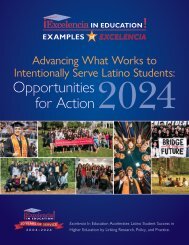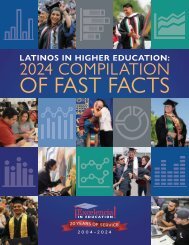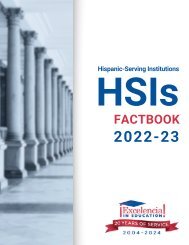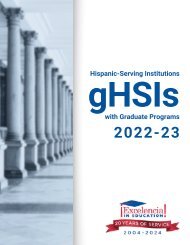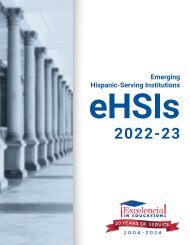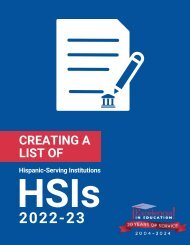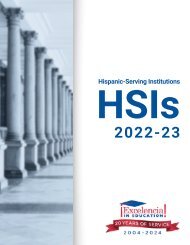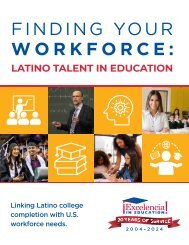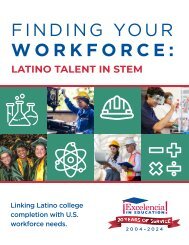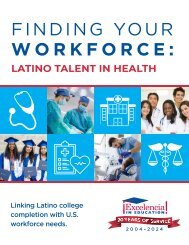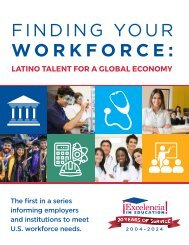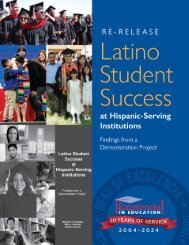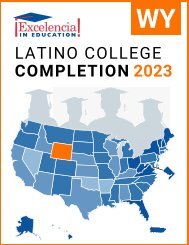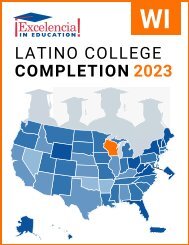Latino College Completion 2023: Hawaii
You also want an ePaper? Increase the reach of your titles
YUMPU automatically turns print PDFs into web optimized ePapers that Google loves.
HI
LATINO COLLEGE COMPLETION:<br />
HAWAII – <strong>2023</strong><br />
For the U.S. to regain the top ranking in the world for college degree<br />
attainment, <strong>Latino</strong>s will need to earn 6.2 million degrees by 2030. 1<br />
FAST FACTS<br />
STATE RANKING:<br />
<strong>Hawaii</strong> had the 39th largest<br />
<strong>Latino</strong> population in the U.S.<br />
K-12 POPULATION:<br />
In <strong>Hawaii</strong>, 19% of the K-12<br />
population was <strong>Latino</strong>. 2<br />
POPULATION:<br />
In <strong>Hawaii</strong>, 11% of the population<br />
was <strong>Latino</strong>. 2<br />
MEDIAN AGE:<br />
The median age<br />
of Hispanics in<br />
<strong>Hawaii</strong> was 26,<br />
compared to 46<br />
for White non-<br />
Hispanics. 2<br />
26<br />
Hispanics<br />
46<br />
White<br />
non-Hispanics<br />
ENROLLMENT:<br />
In <strong>Hawaii</strong>, 22% of Hispanics<br />
(ages 18 to 34) were enrolled in<br />
higher education, compared to 22%<br />
of White non-Hispanics. 2<br />
DEGREE ATTAINMENT:<br />
In <strong>Hawaii</strong>, 37% of Hispanic<br />
adults (25 and older) had earned an<br />
associate degree or higher, compared to<br />
58% of White non-Hispanic adults. 2<br />
Hispanic Adults = 3.7 of 10<br />
To reach the degree attainment goal by 2030, the U.S. can: close<br />
the degree completion gap by accelerating <strong>Latino</strong> completion while<br />
increasing for all students and scale up programs and initiatives that<br />
work for <strong>Latino</strong>, and all, students. The following demographics,<br />
institutional data, and practices inform <strong>Latino</strong> degree attainment.<br />
ENROLLING: Top 5 Institutions (Hispanic Undergraduates) in <strong>Hawaii</strong>, 2021-22<br />
Institution<br />
Sector<br />
Grand Hispanic %<br />
Total Total Hispanic<br />
1 University of <strong>Hawaii</strong> at Manoa Public, 4-year 13,839 1,862 13%<br />
2 Leeward Community <strong>College</strong> Public, 2-year 4,085 690 17%<br />
Private not-forprofit,<br />
4-year<br />
3 <strong>Hawaii</strong> Pacific University<br />
2,726 523 19%<br />
4 Kapiolani Community <strong>College</strong> Public, 2-year 4,039 427 11%<br />
5 University of <strong>Hawaii</strong> at Hilo Public, 4-year 2,630 410 16%<br />
ASSOCIATE DEGREES: Top 5 Institutions Awarding to Hispanics in <strong>Hawaii</strong>, 2020-21<br />
Institution<br />
Sector<br />
Grand<br />
Total<br />
NOTE: We use the terms <strong>Latino</strong> and Hispanic interchangeably in this factsheet.<br />
Hispanic<br />
Total<br />
Source: Excelencia in Education analysis using U.S. Department of Education, National Center for<br />
Education Statistics (NCES), Integrated Postsecondary Education Data System (IPEDS), 2021 Fall<br />
Enrollment, Graduation Rates Survey and Institutional Characteristics Survey.<br />
%<br />
Hispanic<br />
1 Leeward Community <strong>College</strong> Public, 2-year 968 154 16%<br />
2 Kapiolani Community <strong>College</strong> Public, 2-year 811 80 10%<br />
3 Honolulu Community <strong>College</strong> Public, 2-year 560 62 11%<br />
4 <strong>Hawaii</strong> Community <strong>College</strong> Public, 2-year 359 59 16%<br />
5 University of <strong>Hawaii</strong> Maui <strong>College</strong> Public, 4-year 377 51 14%<br />
BACHELOR DEGREES: Top 5 Institutions Awarding to Hispanics in <strong>Hawaii</strong>, 2020-21<br />
Institution<br />
Sector<br />
Grand<br />
Total<br />
Hispanic<br />
Total<br />
%<br />
Hispanic<br />
1 University of <strong>Hawaii</strong> at Manoa Public, 4-year 2,891 322 11%<br />
2 University of <strong>Hawaii</strong> at Hilo Public, 4-year 567 83 15%<br />
3 University of <strong>Hawaii</strong>-West Oahu Public, 4-year 671 73 11%<br />
Private not-forprofit,<br />
4-year<br />
4 <strong>Hawaii</strong> Pacific University<br />
497 72 14%<br />
Private not-forprofit,<br />
4-year<br />
5 Brigham Young University-<strong>Hawaii</strong><br />
592 26 4%<br />
White Adults = 5.8 of 10<br />
1 Projections to 2030: Excelencia in Education. (2020). Ensuring America’s Future: Benchmarking <strong>Latino</strong><br />
<strong>College</strong> <strong>Completion</strong> to 2030. Excelencia in Education. Washington, D.C.<br />
2 U.S. Census Bureau, 2021 American Community Survey 1-Year Estimates
<strong>Hawaii</strong> Gap in Degree <strong>Completion</strong><br />
Closing the degree completion gap can be tracked<br />
by the 4 measures shown below. Alone, none<br />
of these measures capture the entire “story” of<br />
degree completion. However, in combination,<br />
they provide a useful picture of the gap in degree<br />
attainment between Hispanic and White non-<br />
Hispanic cohorts in a single year.<br />
Graduation Rate — Total percentage of students<br />
who graduated within 150% of normal time for<br />
first-time, full-time freshmen. This incorporates<br />
students that graduated in 3 years at two-year<br />
institutions, or in 6 years at four-year institutions.<br />
Transferred to Another Institution —<br />
Percentage of students that transferred to another<br />
institution and did not complete a degree.<br />
Still Enrolled — Percentage of students that are<br />
still enrolled at the point of 150% normal time to<br />
completion.<br />
No Longer Enrolled — Percentage of students<br />
that are no longer enrolled at the point of 150%<br />
normal time to completion.<br />
At two-year institutions, Hispanics’<br />
graduation rate was 3%-points<br />
higher than that of their White<br />
non-Hispanic peers in <strong>Hawaii</strong>.<br />
TWO-YEAR INSTITUTIONS<br />
46%<br />
8%<br />
21%<br />
25%<br />
WHITE<br />
+3%<br />
43%<br />
9%<br />
20%<br />
28%<br />
HISPANIC<br />
DEGREE OUTCOMES<br />
■ No Longer Enrolled<br />
■ Still Enrolled<br />
■ Transferred to<br />
Another Institution<br />
■ Graduation Rate<br />
*Percentages may not add up to 100% due to rounding.<br />
At four-year institutions, Hispanics’<br />
graduation rate was 4%-points<br />
lower than that of their White<br />
non-Hispanic peers in <strong>Hawaii</strong>.<br />
FOUR-YEAR INSTITUTIONS<br />
1%<br />
38% 41%<br />
12%<br />
49%<br />
WHITE<br />
3%<br />
-4%<br />
11%<br />
45%<br />
HISPANIC<br />
NOTE: Outcomes shown are for students at two-year institutions who started in Fall 2018, and<br />
for students at four-year institutions who started in Fall 2015.<br />
Source: Excelencia in Education analysis using the U.S. Department of Education, National<br />
Center for Education Statistics (NCES), Integrated Postsecondary Education Data System, 2021<br />
Graduation Rates Survey and the Institutional Characteristics Survey.<br />
Examples of What Works for <strong>Latino</strong> Students<br />
There are institutions showing success in enrolling, retaining, and graduating <strong>Latino</strong> students. The following are examples of<br />
programs across the country with evidence of effectiveness in serving <strong>Latino</strong> students nominated for Examples of Excelencia.<br />
Gaining Access ‘N Academic Success (GANAS) is an innovative<br />
access and retention program at California State University-East Bay<br />
that targets and serves newly arrived community college transfer<br />
students. The GANAS model offers integrated academic and cultural<br />
approaches that welcome and socialize new transfer students while<br />
increasing their confidence, engagement, resiliency, academic success,<br />
persistence, and, ultimately, baccalaureate degree attainment rates.<br />
GANAS is open to all students. It provides a supportive environment<br />
that focuses on Latina/o and multicultural content. GANAS aims<br />
to smooth the process of transition for <strong>Latino</strong> community college<br />
transfer students and increase baccalaureate degree attainment for<br />
program participants. Once students successfully transfer to Cal<br />
State East Bay, they participate in a 1-year cohort-based learning<br />
community that is paired with a success seminar, intrusive academic<br />
counseling, and peer mentoring. Their cohort model establishes<br />
a sense of familia among its members and builds their academic<br />
and social support networks. By completing the required GANAS<br />
courses, students fulfill their upper division GE requirements. The<br />
courses focus on themes related to <strong>Latino</strong> identity, use innovative<br />
pedagogy, and three of the four courses are taught by <strong>Latino</strong><br />
professors. Beyond the first-year there is continued advising,<br />
graduate school exploration, and community support<br />
GANAS’ 1-year persistence rate is 96%, compared to 86% of non-<br />
GANAS transfer students. The graduation rates of transfer students<br />
who take part in GANAS is 78% in 3 years, compared to 66% for<br />
overall transfer students. GANAS students’ graduation rates for<br />
4-years is 90% and 91% for 5-years. GANAS students graduate at a<br />
faster rate, within 1 to 2 years compared to non-GANAS students.<br />
For more information on institutional programs improving <strong>Latino</strong> student success in higher education, access Excelencia in<br />
Education’s Growing What Works database at http://www.edexcelencia.org/growing-what-works<br />
ENSURING AMERICA’S FUTURE BY INCREASING LATINO COLLEGE COMPLETION • WWW.EDEXCELENCIA.ORG




